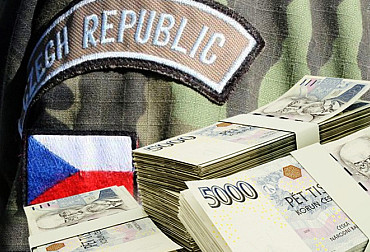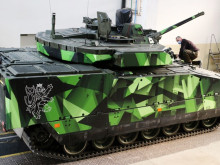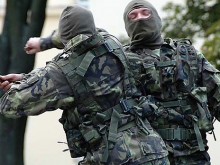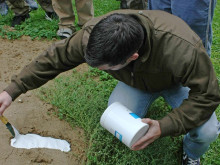Daniel Machač: Forward Air Controllers are Always “in the Firing Line”
They have elite training with British and American colleagues and combat experience from Afghanistan. It is a Czech unit of advanced air traffic controllers JTAC, which guide planes and helicopters towards the targets that are to be destroyed. The unit of "FACs" was established in the Czech army relatively recently, in Náměšť nad Oslavou in 2001. Since then, thanks to considerable combat experience and gained reputation, it has become a small fortune for the army with its top-level capabilities, which is also appreciated by the Allies. It belongs among the elite and strictly guarded treasure of the Czech army. And this Czech elite unit is what we asked about in the interview with a former JTAC member Daniel Machač.
.jpg)
Picture: Equipment currently used by Forward Air Controllers | archive of Daniel Machač
1) Can you specify what concerns the work of Forward Air Controllers? What is most important for this profession? Is it physical training? Mental preparation?
The Forward Air Controller coordinates air or even artillery support with the ground unit maneuver. For this purpose, they have a radio transmitter, rangefinder, laser or laser pointer in addition to the necessary equipment and armament. They help to identify the enemy's position so that the pilot can properly attack the target. The most important thing is to "keep a cool head", to keep track of the situation on the battlefield, and have the ability to orient oneself in the field. Of course, they must be able to use modern military equipment, know the tactics of the unit they support, and last but not least, they must be able to communicate with the pilot in English. This job necessarily requires both physical and mental training. That has to do with what I have already said. After all, a soldier must be equipped with both as soon as he/she enters the war.
2) FAC and JTAC. Are they both the "same unit" just under a different name, or are they two separate units of different specialization?
It is not a unit in either case, it is an expertise. Simply put, JTAC is the US designation for Forward Air Controller, while FAC is the British abbreviation.
.jpg)
Picture: Laser rangefinder with uncooled thermal imaging MOSKITO TI | archive of Daniel Machač
3) Could the training and work of JTAC members be compared to the work of special forces?
In our army, we have Forward Air Controllers who are to support mechanized units. And then there are the Forward Air Controllers for special forces. Everyone must meet the same conditions for qualification. Special forces are, due to the size of the army, a relatively small unit with specific tasks. This places higher demands on the readiness of Forward Air Controllers, be it physical, mental, shooting or tactical and other skills. From my experience, I consider it a great advantage that the Forward Air Controller knows his/her commander and members of the unit for a long time, even from previous training and events, so that their cooperation in crisis situations is much easier and faster.
Picture: In the foreground, there is a laser rangefinder with cooled thermal imaging JIM LR, a display is attached to the helmet to receive a video signal from the aircraft. | archive of Daniel Machač
4) How can we compare our controllers and the foreign ones? In which areas are we lacking and in which are we one up on others?
I've been living a civilian life for two years now. When I worked there, we belonged among the best, which was only confirmed by our work in the missions. We were recognized by the Americans and the British. I received an award from the Americans for bravery in combat, which I appreciate very much. As far as equipment is concerned, we are certainly not lagging behind foreign armies. Today's Forward Air Controllers use most up-to-date devices to communicate and identify the enemy's target, and at the same time, they can transmit target information digitally to other levels of command. The training is also very realistic. It is also thanks to mission experience, which allows instructors to imagine what a situation might look like in a real war. So, I don't think we're lagging behind foreign controllers in anything.
5) What does the profile of a typical Controller in the ACR look like with regard to age, rank, language training, courses…?
I can hardly judge how it is today. While I was working there, they were boys who had already served in the army for several years, some of them went through foreign missions. Everyone had their expertise. There were among them radio operators, analysts, drivers... They were mature men who did not lack the ability to learn new things and wanting to do this job. Language preparation is necessary of course. Every controller must meet the conditions of Stanag 3. After completing it, the applicant is sent to a basic course, where he/she learns the work of a Forward Air Controller. After successful completion, he/she obtains a certificate and then completes his/her qualification under the supervision of instructors.
.jpg)
Picture: Daniel Machač at company tests in Hradec Králové | archive of Daniel Machač
6) What was the most difficult part of your career as a Forward Air Controller? (what you can talk about)
Probably the fear that something might happen to me. And not just because you always have a certain fear, even if hidden somewhere deep. But also because I would not be able to help my comrades-in-arms in the fight from the position of my profession. There were really lots of dangerous situations in which I would find myself. Perhaps the worst was when we were in Afghanistan and drove the car over an improvised explosive system. The lives of the whole unit were at stake then. As a Forward Air Controller, I then called the air support and attacked the enemy.
7) How did you prepare before each deployment? What does the briefing look like?
Before the hustle started, I had to be alright in all respects. First came a task that needed to be elaborated and planned out. I took care of the part that concerned the air force. Both attack aircraft and combat and transport helicopters. I wrote and sent out a request to the individual levels of command, in which we directly specified our task, the space in which we would operate and the way we would use the aircraft. If helicopters were needed to deploy the unit, an appointment and rehearsal of boarding and disembarkation took place before the event itself. Before the task itself, a briefing was held, which summarized the individual tasks for the members of the unit. In addition, of course, I had to find time to prepare personal material. Check weapons, radios, rangefinders, night vision, ammunition, refill water, food. And before the event, I checked the radio connection with the command center via TacSat. When using transport helicopters, I was always the first to stand on the helicopter pad and communicate with their pilots.
Picture: Forward Air Controller Daniel Machač at work | archive of Daniel Machač
8) Part of the work of the Forward Air Controllers is to guide the bombers to the target. Have you ever had doubts or fears that a civilian would show up on the spot?
This is a very sensitive issue. Naturally, I had such concerns and I was always ready to cancel or abort the attack in case of doubt. That's why I always checked the information about the target. Of course, it was easier to attack a target that I saw myself than one that I had learned about from other sources.
9) The work of controllers also means activities close to the enemy, or in enemy territory. How difficult is it to merge with the surroundings, but at the same time arrive at the destination in time? And what about the civilian population? Has there ever been a tense contact situation?
Forward Air Controllers are (probably not for nothing) said to be the first "in the firing line" of the enemy. The enemy is looking for them because he knows about their option and abilities to summon air support and attack. I tried not to look different from other soldiers with whom I went on the mission. Getting to the designated destination can be very difficult. For example, I crept through dense forests at night to get into a position that allowed an overview of the enemy. At other times, it was necessary to climb through mountain terrain to a ridge, from where it was possible to observe the area of interest. We performed the vast majority of tasks at night, when the local people were asleep and did not know about our activities.
10) The JTAC "job" is to guide the aircraft or its smart ammunition to the target. Is their work different, for example, from a forward artillery controller? I suppose it is.
The JFO provides the JTAC with accurate information about the target, they can guide the aircraft to it, but only the JTAC has the permission to drop ammunition. This is the main difference between the work of the JTAC and the JFO. The JFO cannot give permission for an air attack on a target, but the JTAC has this qualification.
11) Does the JTAC need to know the individual specifications of the aircraft and the ammunition used?
The Forward Air Controller learns to know the parameters of individual aircraft and the equipment that the aircraft carries already during the basic training. Ammunition varies and therefore it is necessary for the controller to know the different types of bombs and their specific effects on targets, so that the controller can choose the most suitable one at the moment. In the final stage, the controller does not decide on his/her own. When selecting ammunition, he/she cooperates with the unit commander, who must consent to the chosen ammunition in order to avoid hitting our own units, to prevent the destruction of houses of local residents and possible loss of life of civilians.
12) JTACs use a number of sophisticated electronic devices for their work. However, are they able to fulfil their role without them, e.g. in environments where REB and REP operate?
I think so. Forward Air Controllers undergo training even without sophisticated devices, so they must be able to work in the REB and REP environment, they have their own methods, but I do not want to describe them in detail. There are certain procedures that Forward Air Controllers perform to ensure not only the acquisition of information about the target but also the connection between the pilot and the aircraft. They can use paper maps, JTAC rulers, compasses, which are used to determine the enemy position. Some devices of Forward Air Controllers are interference-resistant and can still receive a GPS signal.
.jpg)
Picture: Daniel Machač during company tests, where he uses the equipment of a Forward Air Controller. | archive of Daniel Machač
13) Are the means to destroy the target chosen directly by the JTAC member because he/she is situationally aware of the target, or are these means chosen at a higher level of command?
Each mission has its own rules of combat and allows for different uses of weapons. It might happen that the target is in an endangered area of attack. For example, in civilian buildings or on other civilian property. When the commander of the unit cannot decide on the attack on the basis of the Forward Air Controller's recommendation, it moves up to the higher command. The same procedure occurs, for example, when an aircraft carries a bomb that does not suit the situation. Even then the commander of the unit asks the higher command for permission to use such ammunition. However, when the unit gets into a situation that endangers our lives, only the commander of the unit decides on the attack on the basis of his own information. But then it is a matter of self-defence.
14) You are currently living a civilian life and work for a company that supplies special military equipment. What is your position there and do you think that your previous military career is an advantage?
I must say first that during my military career I have held several positions in various types of troops (artillery, mechanized units, air force and special forces). I participated in a total of seven foreign missions (Bosnia, Kosovo, Afghanistan). So, I gained knowledge and experience that later, in the position of the Forward Air Controller, helped me think more comprehensively and I knew better what to do in difficult situations. I had the opportunity to try out a variety of devices that allowed me to do this work faster, more accurately and more efficiently. As an instructor, I was able to pass on this experience to younger colleagues, whom I was preparing for the position of Forward Air Controllers.
I work as a training instructor in a company that, among other things, deals with the supply of devices for Forward Air Controllers. I need to understand the most up-to-date equipment that the company manufactures and supplies, know their capabilities, be able to handle them in tactical situations so that I can introduce them to the military and the units that will use them. I can also vividly imagine the use of this equipment in a war, so I can give the company feedback. I also train soldiers. This close cooperation between the company and the army proves that my previous military career is an advantage.
Video: Czech unit of advanced air traffic controllers JTAC / YouTube












.JPG)
.JPG)




